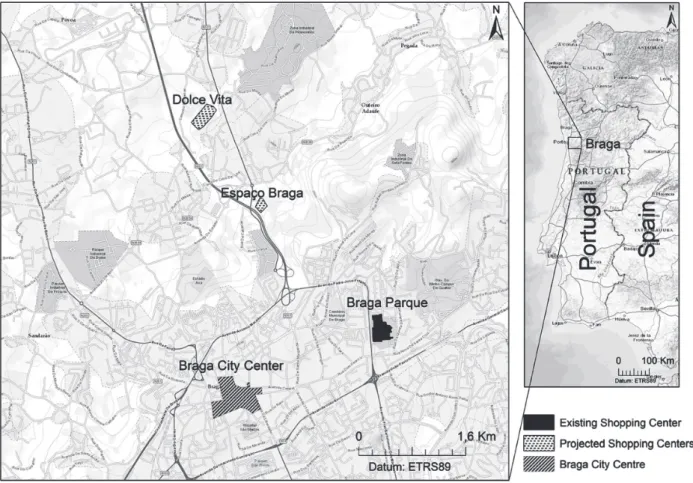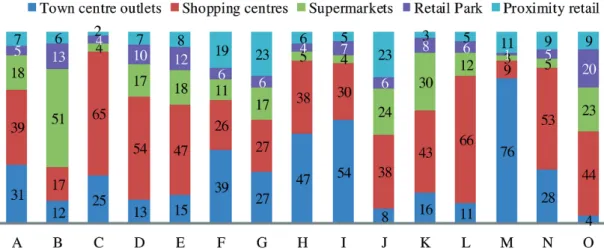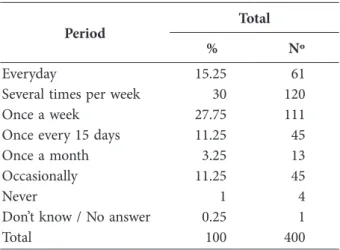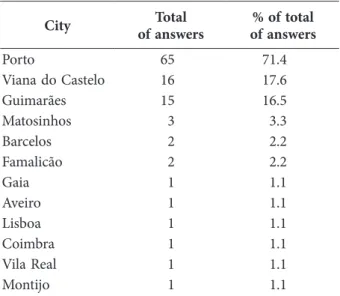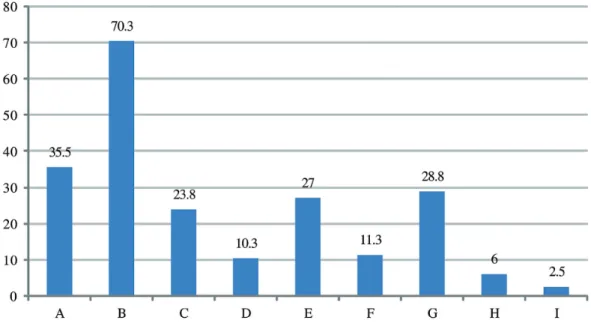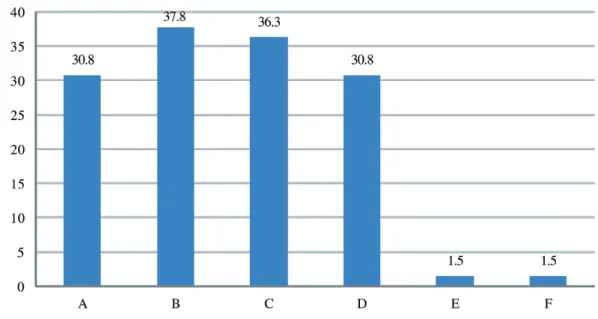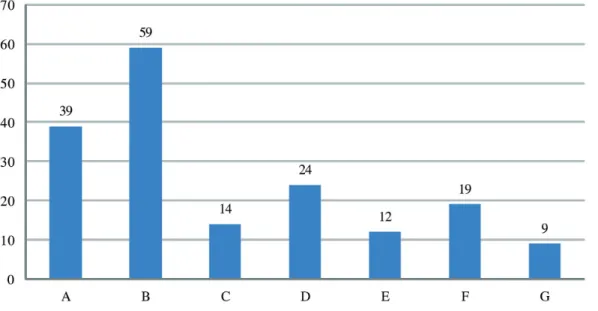ISSN 1732–4254 quarterly ISSN 1732–4254 quarterly journal homepages: http://www.bulletinofgeography.umk.pl/ http://wydawnictwoumk.pl/czasopisma/index.php/BGSS/index http://www.degruyter.com/view/j/bog
Bulletin of GeoGraphy. Socio–economic SerieS
The prospective impact of new shopping centres
on the retail structure of Braga
pedro porfirio Guimarães
CDFMRCentre for Geographical Studies – Lisbon University, Edifício da Faculdade de Letras, Alameda da Universidade, 1600-214 Lisbon, Portugal; phone: + 351 217 940 218, 217 965 469, fax: +351 217 938 690; e-mail: pedroguimaraes@campus.ul.pt
How to cite:
Porfirio Guimarães, P., 2014: The prospective impact of new shopping centres on the retail structure of Braga. In: Szymańska, D. and Środa-Murawska, S., editors, Bulletin of Geography. Socio-economic Series, No. 25, Toruń: Nicolaus Copernicus University Press, pp. 167–180. DOI: http://dx.doi.org/10.2478/bog-2014-0037
abstract. Following the application for two new shopping centres in the city of
Braga, a medium-size city located in the North region of Portugal, the purpose of this paper is to look for evidence of the possible impacts of those commercial structures on the retail sector of Braga. An overview of the literature allows us to conclude the strong relation between retail and cities and their town centres. Re-cently, the process of suburbanization and the transformation in the retail sector put into question the role of those areas by transferring the consumption from town centres and traditional retail formats to new structures located on the pe-riphery. 400 questionnaires were given to consumers to analyse the consumption habits and the way they might change with the possible arrival of two new shop-ping centres. We have come to the conclusion that these commercial structures are very much present in the consumption habits and in the commercial environ-ment of consumers. They associate characteristics like quality, animation, security, cleanness, time saving, product diversity, comfort, conviviality and parking facil-ities with that retail format. With the implantation of new shopping centres it is expected that the existent retail sector will undergo a decrease in its importance as a shopping destination. The data from the questionnaires allow us to conclude that it is not only the already existent shopping centres that will suffer but also the other retail formats. Nevertheless, a significant number of respondents do not think of transferring the shopping they already do to the new retail structures.
contents:
1. Introduction . . . 168 2. Material and research methods . . . 170 3. Retail formats and consumer perception . . . 171
article details: Received: 06 November 2013 Revised: 04 March 2014 Accepted: 26 May 2014 Key words: Portugal, shopping centres, town centres, retail structure, consumption habits. © 2014 Nicolaus Copernicus University Press. All rights reserved.
3.1. Characteristics of different retail formats. . . 172
4. Consumption habits . . . 174
5. Prospective analysis of the change in the consumption habits . . . 177
6. Conclusions . . . 179
Notes . . . 179
Acknowledgement . . . 179
References . . . 179
1. introduction
Cities have evolved over time for different reasons. In the last decades, transformations in cities and in the retail sector have been provoking deep changes in the hierarchical structure of cities. Among oth-er causes of change, the dissemination of new re-tail formats in peripheral locations has diminished the vitality and viability of town centres. These are-as, especially historic centres, concentrated a diverse set of functions, endowing this location with a cen-trality not seen in other areas. In this way, tradition-ally, cities and their main centre were characterized by their centrality. Related to this and tied to the fate of cities, retail has always maintained a priv-ileged place in the town centre (Beaujeu-Garnier, 1980: 209).
However, the claim that cities have one centrali-ty, their historic centre, with relevant social, cultural and economic functions, is no longer applicable in the majority of cases. Cities have witnessed a pro-found change in their shape and boundaries with strong implications on their monocentric structure. In the last decades of the last century we saw pro-found changes that led to increased fragmentation of the spatial organization (Barata-Salgueiro, 2001).
Barata-Salgueiro (2001) refers to the phenome-non of spatial fragmentation, of the construction of polycentric metropolises, exemplifying how the po-larities created by the opening of a new shopping centre “Amoreiras”, in 1985, on the boundaries of Lisbon had a direct relation to the loss of attractive-ness of the historic town centre of that city.
Generally, it can be said that the problems of inner cities have a structural nature. They are the result of the decentralization of different sets of functions like housing, retail, services and enter-tainment (Balsas, 1999). According to Chico (2008),
other elements of urban character have contribut-ed to the degradation of the quality of the historic town centre. The author highlights the massive use of the private car, facilitating access to housing on the outskirts of cities; the loss of multi-functionali-ty, which intensified the desertification of these ar-eas after a certain hour of the day; degradation of the buildings; and high rents. Despite being more than a shopping area, if a town centre loses is at-tractiveness as a centre of retail, it can hardly sur-vive as a centre in the wider sense. Retail is clearly its essential component (Balsas, 1999: 51).
Barata-Salgueiro (1992: 298), in the same sense claims that cities are fundamentally tertiary centres. This author argues that the relation between retail and urban or rural spaces derives from the prop-erties of modelling space for these activities which have been systematized in Christaller’s famous Cen-tral Place Theory. The concepts of cenCen-trality and concentration are especially important due to their relevance, i.e., they were once the main advantage of town centres and are now currently being worked out in detail and effectively by new shopping cen-tres. These can, through the good accessibility they possess, constitute themselves as new centralities. In the same sense Pereira (1999: 97) argues that the structure of urban-scale retail organization loses its monocentric character and, alongside the traditional town centre, arise recent peripheral concentrations.
Although this is a relatively recent phenomenon in Portugal, Beaujeu-Garnier (1980: 213), some dec-ades ago stated that the retail sector of the town centre was confronted, more or less violently, with modern peripheral deployments. The crisis of town centres is already recognized. The need for recovery is also consensual in the political agenda. The im-plantation of diverse measures can be seen in sev-eral national contexts. The pedestrianization of high
streets, the application of management principles in town centres and the adoption of restrictive meas-ures (regarding the opening of new retail structmeas-ures in peripheral areas) are among some of the most common.
In the present context, shopping centres occu-py a central role in the commercial environment of our cities. Having undergone great development in recent decades, it is possible to verify that the ex-pansion of shopping centres has been accompanied by a steady improvement in the variety of shapes, models and deployment locations.
According to Beaujeu-Garnier (1980), the first planned shopping centre with a peripheral location appeared in 1923, near Kansas City: The Country Club Plaza. In the Portuguese context, shopping centres slowly appeared in the 1970s. The dissemi-nation on a large scale happened during the 1990s and subsequently throughout the new century.
Based on Jayne (2006), Cachinho (2006:43) as-sumes that success of modern shopping centres de-rives from the fact that they epitomize suburban values and can be easily replicated and built an-ywhere in the city to meet the needs and desires of middle class consumers. Thus it creates an im-portant relationship between cities, their commer-cial spaces and their population, leading Cachinho (2006: 48) to admit that the current city is above all a centre of consumption and entertainment, organ-ized around the commercial areas.
Generally we may say that the emergence of new shopping centres on the outskirts of cities had much influence on the decline of urban centres and on the retail outlets located there (Balsas, 2001:7). We can assume that some of these impacts were due to non-recognition of the retail sector as relevant, both to the local economy and to the vitality of the are-as where it is located. Williams (1997:205) said this sector was seen as having a small relevance in the economic sector. This lack of recognition may, in-itially, have facilitated the spread of shopping cen-tres in peripheral areas. It was with the subsequent appearance of the first impacts that the retail sector increased its importance.
There is some literature about the impacts of the new shopping centres on the existing retail struc-ture, some of these regarding the British context. A study by Howard and Davies (1993) demonstrat-ed that the opening of the Metro shopping centre
in the northeast of England, during the 80s, caused significant impacts, not only in the traditional city centre but also in other smaller shopping centres. According to Whysall (1995: 6) the implementation of a superstore near the town centre of Nottingham, in the 1990s, withdrew consumers from the pre-ex-istent retail structure of the town centre. In South-ampton, the opening of a shopping centre at the beginning of the new millennium did not provoke the negative effects that were somehow expected. Possibly, because it was implemented in the town centre, it might even have increased the footfall in the area (Lowe, 2005:663).
Guy (2007:133) also admits the negative im-pacts of peripheral shopping centres in the func-tional structure of city centres. According to this author the entry of some stores to the new shop-ping centre will lead to an increase in the number of vacant shop units in the town centre, worsening the environment of this area.
In the Portuguese national context, we can high-light the studies conducted by Cachinho (2005) and Barata-Salgueiro (2007), for assessing the impacts of new shopping centres in the cities of Leiria and Évora and the study by Lopes (2004), which as-sesses the impacts of the implementation of a new commercial structure to the town centre of Almada. The first study focused on evaluating the feasibili-ty of implementing new shopping centres of signif-icant size in the city of Leiria (Cachinho, 2005: 5), through the analysis of three commercial projects, coming to the conclusion that the impacts of large shopping centres are very diverse and affects dif-ferent business. However, these impacts could be mitigated if shopping centres were located in the city center. (Cachinho, 2005:402). The second study concluded that the implementation of a regional shopping centre would be beneficial to the city of Évora. As there was no large shopping centre in that city, the opening of one would cause a decrease in the flow of consumers that moved to large shop-ping centres located in other cities (Barata-Salgue-iro, 2007:20). In the case of the study initiated by Lopes, his research focused on understanding the impacts caused by the opening of a new shopping centre, in this case the Almada Forum. This re-search, unlike the first, was held after the opening of the shopping centre. “With regard to the impact of the opening of Almada Forum on the retail
sec-tor of the town centre, it can be said that this was not globally as negative as some retailers predicted and was felt differently by different typologies of re-tail” (Lopes, 2004:124).
Like, for instance, superstores in the UK and hy-permarkets in France and Belgium it was not shop-ping centres that first provoked impacts on the retail structure of Portuguese town centres. Focus-ing in Braga, a study sponsored by Braga Chamber of Commerce concluded that the deployment of the first hypermarkets in that city caused some nega-tive impacts on the retail sector of the town cen-tre and on sales and profit margins, with over 80% of respondents having said they found a decrease in the number of customers. These impacts were not, however, homogeneous by different types of typolo-gies, being stronger on grocery stores and on those that sold appliances. Some of the aspects mentioned as causes of this situation relate to some of the ad-vantages of shopping centres, i.e., “prices, variety of products, promotions, parking facilities ...” (Farhang-mehr, 1996: 42). The same study raises some doubts as to other aspects that might have provoked im-pacts. In fact, although the emergence of hypermar-kets has, by itself, led to changes in the volume of sales, the opening hours to the public emerged as an important aspect. Respondents admitted that the opening of stores on Saturday afternoon, at lunch-time and between 19h and 20h30 during weekdays is what most suits their time available for shopping. However, it was determined that the outlets locat-ed in town centres were closlocat-ed at this time. In an-other area of the city, two thirds of retailers, when this study was conducted, admitted that the exist-ence of training was very important. However only 2.6% of retailers provided training for their employ-ees. In the cases where training was given, most of the time it was given by the owner / manager with-out resorting to external and specialized companies. According to Observatório do comércio (2002:88), this process began after the Second World
War with suburbanization and rapid expansion of new retail formats – hypermarkets, shopping cen-tres, discount stores and convenience stores – on the outskirts of the main city centre. Eventually this contributed to the abandoning of inner cities, both by the population and by economic investors (Observatório do comércio, 2002:88). Due to the dimensions of the new retail agglomeration, they eventually constitute themselves as alternative com-mercial poles to the pre-existent town centre (Fern-andes, Cachinho and Ribeiro, 2002).
The legislative framework in Portugal, although restrictive, does not prevent the opening of new shopping centres. The opening of new commercial structures is seen as positive, mainly because of creasing the commercial offer of the city and in-creasing the number of jobs. In another context, even considering that the impacts will be negative for the functional structure of the city, the munic-ipal officials prefer to approve the implementation of new shopping centres, because in case of refus-al, they may come to be located in another adjacent municipality, keeping the negative impacts.
2. material and research methods
Braga is a historic medium-sized city located in the North region of Portugal. It is usually known as the “capital of retail” due to a wide pedestrian area in the town centre, which led to an approach from the Chamber of Commerce with a marketing campaign recognizing the area as an “open air shopping centre”.
It is a growing city, in terms of population (Ta-ble 1), mostly due to its dynamic university, which attracts a huge number of young students to the city every year. A large number of these eventually stay in the city after graduation, explaining the high rates of population increase that we see through the data from the national census of 1991, 2001 and 2011.
table 1. Population of Braga municipality, in 1991, 2001 and 2011
area year Variation (%)
1991 2001 2011 1991 - 2001 2001-2011 1991 - 2011
Portugal 9,867,147 10,356,117 10,561,614 5 2 7
Braga 141,256 164,192 181,474 16.2 10.5 28.5
There are two significant shopping centres, one of which, Braga Parque, the most important of the two, with almost 50,000m2 of gross leasable area
(GLA), is located just on the outskirts of the town centre but clearly in the city area.
Recently two different promoters showed inter-est in building two shopping centres. Both of the projects indicated that the location would be outside what we might consider the urban area, although it would still be located in the municipality, close to one another, in a new area of expansion of the city.
fig. 1. Retail concentrations in Braga
Source: Cartography developed by the author (2014)
The city centre shown on the map is the main centre of Braga, which is still characterized by an evident concentration of the retail sector and some public services in this area.
Taking these projects into consideration, a series of questionnaires was undertaken by the author, in order to establish what the possible impacts of the shopping centres on the pre-existent retail structure of the city could be.
The material presented in this paper began to be collected during 2009. A series of 400 question-naires filled in by consumers was collected. The
survey was conducted personally by the author in several streets in the town centre, at different hours of the day, in order to diversify the respondents’ profile.
3. retail formats
and consumer perception
In the following pages will be presented some of the data collected through the questionnaires
men-tioned above. They were divided according to sev-eral topics.
In Figure 2 we present the results of the asso-ciation between a given characteristic with a retail format. The choice of answer was predetermined between: (i) outlets located in the town centre; (ii) shopping centres; (iii) supermarkets; (iv) retail parks; (v) proximity retail. With the pre-determina-tion of the possible answers we intend sometimes to mix retail formats and retail locations because the evolution of the retail sector is providing a set of different combinations. In an extreme situation a shopping centre, according to its location, can be situated in a peripheral location or in a town cen-tre location. In both cases shopping cencen-tres can per-form as a proximity retail structure, serving the part of the population that is no longer concentrated in the compact city but dispersed across the policentric
city. However, the respondents were given the free choice of response because we consider that it is also relevant to analyse the subjectivity of their response. 3.1. characteristics of different retail formats Regarding “Quality”, 39% of respondents associate this feature with shopping centres. This is probably a consequence of how these structures operate. En-dowed with a management unit, this aspect allows them to work the common space, somehow making the consumer believe they are in an improved pub-lic space. The establishments of the town centre also received a significant percentage of answers (31%). The other formats achieved less significant values. Despite this, supermarkets still received 18% of the total of answers.
fig. 2. Relation between different features and retail formats, as a percentage
Explanation: A – quality; B – price; C – animation; D – security; E – cleanness; F – personalized service; G – trust; H – environment / beauty of the place; I – leisure; J – time saving; K – product diversity; L – comfort; M – history; N – conviviality with friends / relatives; O – parking facilities
Source: Surveys conducted by the author on consumers in the city of Braga (2009) With regard to “price”, the situation changes,
with supermarkets obtaining 51% of the preferenc-es. This choice is probably due to the fact that in this format we included discount stores, whose “white label” product prices are cheaper than the brand-ed products. Retail Parks have 13% of the choices, below shopping centres, with 17%, but above the outlets of the city centre, with 12%, and proximi-ty retail with 6%.
The characteristic “animation” is the second one in which responses are more unanimous. The ma-jority of consumers have the opinion that anima-tion is felt more significantly in shopping centres. Again, as noted above and as will be inherent in other characteristics such as safety, comfort and cleanliness, the management unit enables joint ef-forts, facilitating the development of animation ac-tivities which would not be possible to undertake
individually by retailers. This feature is less asso-ciated with the town centre. The lack of periodic animation that attracts new customers or, at least, helps maintain the existing ones, has been identified as one of the main shortcomings of town centres. The balance contrasting with the shopping centres is explained by the absence of a management unit.
Although Braga is recognized as a safe city, con-trarily to what happens in other Portuguese cities, the respondents still associate “security” with shop-ping centres. What might help explain this result is the perception of safety that exists in those spac-es due to the constant prspac-esence of private security.
Cleanness has clearly a more homogeneous dis-tribution. Although shopping centres still receive 47% of responses, other types increased if compared with values obtained for the previous feature.
As for the “personalized service”, its associa-tion with the town centre establishments is proven (39%). Thus, respondents considered that existing establishments in this area have a more personalized service than the ones which are located in the oth-er retail formats. The proximity retail also achieves a high value with 19% of respondents considering that in these stores the service is more personal-ized, achieving almost the same value as shopping centres (26%).
The characteristic “trust” is one in which an-swers are distributed more evenly, with shopping centres and outlets of the town centre both obtain-ing 27%. The lowest value was achieved by Retail Parks, with only 6%. The value reached by the latter is explained by lack of knowledge of the population regarding this retail format, with a late arrival in Braga’s commercial environment (2007). The 23% of responses that associate trust with proximity retail is explained by the nature of these establishments, in which both the retailer and the consumer know each other.
Regarding the “environment/beauty of the place”, the town centre and the retail sector that exists in this area acquired prominence in the respondents’ preferences with 47%. Shopping centres also achieve a high percentage of opinions, with 38%, leaving the remaining retail formats with residual values. The association of this variable with the city centre is somehow due to the historic identity that exists in this location, with the presence of monuments and historical sites. On the other hand, the
asso-ciation made with shopping centres is due to the fact that in many cases these spaces create artificial environments, trying to recreate the public space, through various hallways, “imitating” the city cen-tre appearance.
Regarding the variable “leisure”, the city centre is clearly the prime location. This distinctive look is due to the importance that this area still has among the local population. Unlike other cities, the city of Braga managed to hold this function in its historic centre. It managed to keep its commercial offer and increased its pedestrian area, maintaining its attrac-tiveness in comparison to other areas. Only shop-ping centres achieved a significant percentage, with 30% of respondents preferring these spaces. The re-maining concepts and locations fail to have a sig-nificant percentage of the total set of respondents. The link between trade and leisure, as analysed by Howard (2007), is significant. This author admits that shopping itself is a leisure activity. In this sense the relevance attributed to the city centre seems to indicate its relevance as a business destination.
Shopping centres are at the top regarding the preference of respondents when asked what is the most time saving retail format and location, with 38% of the responses obtained. This value is related, in part, with parking facilities and product diversi-ty. Thus, the easiness of parking in these commer-cial spaces, endowed with a high number of parking spaces, free (in some cases) for their users and the diverse set of existing outlets grouped in an area, more or less extensive, allows the acquisition of a large range of different products in a short period of time.
Similar to the previous feature, a significant per-centage of respondents (43%) is of the opinion that, with regard to the “product diversity”, the shopping centres have greater relevance. The existing com-mercial mix is the result of the professional manage-ment of these commercial structures. The concern of their administrations in getting together in the same space diversified establishments is recognized by consumers, who can thus better organize their shopping. It is also worth noting the number of re-spondents who prefer supermarkets (30%), reveal-ing the effort, undertaken in recent years, of those establishments to diversify the products they sell, managing to sell a larger list of products, which usually rely on food, clothing, household
applianc-es, “DIY”, toys, and stationery, among others. The town centre outlets only received 16% of prefer-ences, which denounces the excessive specializa-tion, mainly in personal items, especially clothing.
As for the “comfort”, it was recognized by the respondents as the feature with the highest weight in shopping centres, compared to other commer-cial types. In fact, 66% of respondents reveal these spaces possess this quality. The construction of an artificial “public space” within a closed space, al-lows the construction of experiences, benefiting from the comfort of movement in an enclosed, air-conditioned area, with places to rest equipped with sofas, among other commodities. This set of features is mostly found in these commercial spaces. In the other formats and locations, by contrast, although they may possess one or another commodity, their assembly does not occur.
The factor “history” is one that brings greater consensus, with 76% of respondents opting for the establishments of the town centre. These areas pos-sess a quality that arises from the agglomeration of monuments, historical references, architectural fea-tures and the whole history of the city that is diffi-cult, if not impossible, to reproduce in other places of the city. The city centre of Braga does not es-cape from this trend, due to its historic relevance. Consumers recognize these characteristics, justify-ing the achieved value. Proximity retail, portrayjustify-ing a more recent history, emerges with 11% of opin-ions of respondents. Shopping centres, recent spac-es, given the history of the city, still reach 9% of the total. Nonetheless, this value may be due to the at-tempt of the management unit of these structures to recreate the feeling of the historic city, within their physical space. One example can be the occasion-al photographic exhibitions appeoccasion-aling to this senti-ment. Retail Parks, because of their very concept, by their nature and recent date of opening, obtained an insignificant value.
It was also possible with the questionnaire to find out that 53% of consumers choose to attend a shopping centre when they intend to spend time with friends or relatives. Following the recognition of shopping centres as places that are comfortable to attend, the option to socialize is a natural asso-ciation.
In respect to “parking facilities”, there is a more distinct division than for the above feature. Thus,
shopping centres, due to the high number of park-ing spaces available, while maintainpark-ing the higher number of positive associations (44%), are followed more closely by supermarkets and retail parks. The 23% achieved by supermarkets is due to the fact that some of them have their own car park reserved for customers. Others are located in residential ar-eas, where parking exists. In other cases, there are private parking facilities with which some super-markets have agreements, allowing the customer to shop and receive a discount on the price to pay. The high value achieved by Retail Parks for this feature is justified by the parking spaces they possess. The value achieved by outlets of the town centre is a re-flection of the low number of parking spaces in this area. Although, sometimes, there are some parking facilities, the price charged is too high and pushes consumers to other retail formats.
4. consumption habits
use of shopping centres, according to regularity
As we can see in Table 2, more than two thirds of respondents admit attending one or more shopping centres, at least once a week, and 30% of them at-tend these spaces several times per week.
table 2. Frequency of use of shopping centres
period total
% nº
Everyday 15.25 61
Several times per week 30 120
Once a week 27.75 111
Once every 15 days 11.25 45
Once a month 3.25 13
Occasionally 11.25 45
Never 1 4
Don’t know / No answer 0.25 1
Total 100 400
Source: Surveys conducted by the author on consumers in the city of Braga (2009)
Another important fact to note is the number of respondents that state they do not attend
shop-ping centres. Only 1% of respondents do not have the habit of visiting them. This value highlights the importance that these spaces have in today’s com-mercial environment. If we consider that these spac-es are somehow recent in Braga, we come to the conclusion that the use of these commercial spac-es has replaced the use of another space of differ-ent retail format.
use of shopping centres, according to days of use
The use of shopping centres which, as we have seen, is quite regular, is also distributed similarly through-out the week (Table 3). Although weekends are the prime preference, when a part of the population is in the weekly pause, the trip during weekdays both day and night is quite usual. Thus, from the point of view of existing commercial establishments within it, this attendance allows retailers to sell their prod-ucts more evenly, diminishing the weaker periods during the week.
table 3. Period of use of shopping centres
period total
% total
During daytime on weekdays 40.3 161
Overnight on weekdays 34.8 139
Weekends 43.5 174
Don’t know / No answer 2 8
Source: Surveys conducted by the author on consumers in the city of Braga (2009)
use of shopping centres, according to municipality
Of all consumers surveyed, 94.5% admitted tending shopping centres in Braga and 24.5% at-tend centres in other cities (Table 4). Although, of course, there are consumers who attend both shop-ping centres in Braga and outside of the city, the ex-istence of 24.5% of consumers who shop outside the city implies the attractiveness of other cities, with which the existing supply in Braga cannot compete. This percentage of consumers is not explained by
their municipality of residence because, the major-ity of respondents that do not live in Braga have their housing in municipalities where there are no shopping centres, mostly small municipalities locat-ed north of Braga.
Of all respondents that shop in shopping cen-tres located outside Braga (24.5%), 71.4% prefer to shop in those formats located in Porto, the second largest city and capital of a metropolitan area, lo-cated around 50km from Braga. Several shopping centres were referred to such as Dolce Vita Por-to, Norte Shopping, Shopping Mar, Via Catari-na, El Corte Inglês, and Arrábida Shopping. Other cities were mentioned, although in a much small-er degree, like Guimarães: despite thsmall-ere being only 9 respondents from Guimarães municipality, there are 15 who admit attending the Guimarães Shop-ping. This situation happens with the city of Viana do Castelo. With only 2 respondents of this county there are 16 attending the shopping centre Estação Viana. These examples show the escape of consum-ers to other municipalities. If in the case of Porto, it possesses a strong commercial provision, in the other two cases, Guimarães and Viana do Castelo, the commercial offer is significantly lower than in the city of Braga.
table 4. Locations of shopping centres frequented outside
Braga
city of answerstotal of answers% of total
Porto 65 71.4 Viana do Castelo 16 17.6 Guimarães 15 16.5 Matosinhos 3 3.3 Barcelos 2 2.2 Famalicão 2 2.2 Gaia 1 1.1 Aveiro 1 1.1 Lisboa 1 1.1 Coimbra 1 1.1 Vila Real 1 1.1 Montijo 1 1.1
Source: Surveys conducted by the author on consumers in the city of Braga (2009)
travel motivation
The motivation to travel to shopping centres was the target of a question to which 70.3% of respond-ents said that the reason for travelling to these com-mercial spaces is in order to shop (Fig. 3). Of the total respondents, 35.5% admitted that the main motivation is leisure. This percentage enhances the
importance of this feature in the attraction of con-sumers. The transformation of private space and its “artificial” transition into public space, albeit with-out some of the problems encountered in public space, is a key element that characterizes commer-cial spaces. Enhancing their position as anchors, the values achieved by the cinema and hypermarket are very relevant, with 27% and 28.8% of preferences, respectively.
fig. 3. Motivation for travelling to shopping centres, as a % of respondents
Explanation: A – leisure; B – shopping; C – meeting with friends; D – restaurant; E – cinema; F – coffee house; G – hypermarket; H – other; I – no answer
Source: Surveys conducted by the author on consumers in the city of Braga (2009)
habits of use
The relationship between shopping centres and the leisure feature has become visible in previous ques-tions. Therefore it was asked with whom they usu-ally went to those spaces (Fig. 4). More than one
third of consumers travelled with family or friends to those commercial spaces. Because those are plac-es in which a considerable number of people go for leisure (although they might shop once inside), the percentage of respondents that go alone is only 30.8%.
fig. 4. Person who usually accompanies you on the trip to shopping centres, as a % of respondents
Explanation: A – alone; B – relatives; C – friends; D – boy/girlfriend; E – others; F – no answer Source: Surveys conducted by the author on consumers in the city of Braga (2009)
5. prospective analysis of the change in
consumption habits
use of new shopping centres
Regarding use of new shopping centres, once they are open, 44% of respondents admit attending these spaces and 45% say they will go. Only 11% of
re-spondents do not consider this possibility, saying that they will not attend the new spaces (Fig. 5). The fact that new shopping centres were only in the application phase and advertising campaigns allud-ing to them were not yet visible, it is expected that the number of consumers who might attend these new centres will be even higher than the number presented in this investigation.
fig. 5. Intention of future use of new shopping centres, as a % of respondents
reasons for use new shopping centres Of the 400 respondents, 59% admit coming to shop in new retail spaces. In the same segment, 39% admit
frequenting them just for leisure. Anchor stores are of most importance in this analysis. Still not knowing what stores might appear as an anchor, the existence of a cinema and hypermarket ensure by themselves an important attractiveness for these spaces.
fig. 6. Motivation for future use of new shopping centres, as a % of respondents
Explanation: A – leisure; B – shopping; C – restaurant; D – cinema; E – coffee house; F – hypermarket; G - other
Source: Surveys conducted by the author on consumers in the city of Braga (2009)
transfer of shopping
It was concluded that, of the 400 respondents,
43 assume they will transfer the purchases they cur- rently do at existing stores in the centre of the city of Braga (Fig. 7).
fig. 7. Origin of shopping transfer (intention), in number of responses
Explanation: A – outlets of the town centre; B – other shopping centres that exists in Braga; C – shopping centres in other cities; D – proximity retail; E – I don’t think in transfer the shops that I presently do
A stronger relationship is verified with the trans-fer of purchases made in other shopping centres in the city of Braga to new ones, with over 23% of con-sumers admitting this fact. The transfer of purchases made in shopping centres in other cities is also very relevant with 46 respondents adopting this possibil-ity, which represents over 11% of respondents. Pur-chases made in proximity retail will be the format with the lowest decrease with only 20 respondents ad-mitting this possibility. Of the total respondents, 54% did not think of transferring their purchases. While it may seem like a high number, when considering the total universe of consumers, the possible change in consumption habits of 46% of current consumers may have repercussions and produce changes in the current trading system in force in the city of Braga.
6. conclusions
The evolution of the retail sector alongside some changes in cities, especially the process of subur-banization, put some pressure on town centres, primarily on the main historic town centre. The strong relation between cities and retail means that the transformation in one will have consequences on the other. Alongside suburbanization, the ap-pearance and dissemination of shopping centres in peripheral areas will enhance the impacts on town centres. The relevance of that retail format was confirmed in the questionnaires, with aspects like quality, animation, security, shopping time sav-ing, product diversity, comfort and parking facili-ties enhancing the role of shopping centres in the commercial environment of Braga. Therefore the implantation of new shopping centres in Braga will change the consumption habits. 46% of respondents admitted the probable transfer of part of their shop-ping from the existent retail to the new commer-cial structures. The expected impacts will be felt not only in the retail sector in the town centre but also in other retail formats like already existent shop-ping centres. This transformation may cause pro-found impacts in the vitality and viability of the retail sector and the areas where it is located. In terms of planning, the opening of the new shopping centres will, probably, trigger the adoption of reac-tive measures, in order to minimize these impacts.
In addition to the impacts on the retail sector, the opening of large commercial structures outside the city centre can help accentuate the urban sprawl in peripheral areas. In this case, on the one hand, it can help increase the pressure for construction in non-urbanized areas, weakening natural resources. On the other hand, it may reduce the willingness for urban regeneration, especially in the old histor-ic centre of the city.
notes
(1) It was possible to give a multiple response. Of the total of respondents that shop outside Bra-ga (98) only 91 specified the city in which they shop. The consumers who admitted attending shopping centres in Porto, probably visit shop-ping centres that are located not in the city of Porto but in its region. The reason for this is that it is usual to designate as “Porto”, areas that in fact belong to other municipalities, that is, this designation may cover an area larger than the administrative boundaries of Porto munici pality.
acknowledgement
An acknowledgement is made to the Portuguese funding agency: FCT – Fundação para a Ciência e a Tecnologia, for funding the PhD on which the re-search is based.
references
Balsas, c., 1999: Urbanismo comercial em Portugal
e a revitalização do centro das cidades (Commercial Urbanism in Portugal and the revitalization of city centres – in Portuguese), Lisboa: GEPE.
Balsas, c., 2001: Urbanismo comercial em Portugal,
a necessidade de uma nova gestão urbana (Commer-cial Urbanism in Portugal, the need for a new urban management – in Portuguese), Lisboa: URBE.
Barata-Salgueiro, t., 1992: A cidade em Portugal (The
city in Portugal – in Portuguese), Porto: Afrontamento.
Barata-Salgueiro, t., 2001: Lisboa, Centralidades e
Pe-riferia (Lisbon, Centralities and Periphery – in Portuguese), Oeiras: Celta Editora.
Barata-Salgueiro, t., 2007: Avaliação dos impactos dos
centros comerciais na cidade de Évora (Assessment of the impacts of shopping centres in the city of Évora – in Portuguese), Lisboa: GECIC.
Beaujeu-Garnier, J., 1980: Geografia Urbana (Urban
Ge-ography – in Portuguese), Lisboa: Fundação Calouste Gulbenkian.
cachinho, h., 2005: Avaliação dos impactos dos centros
comerciais na cidade de Leiria (Assessment of the im-pacts of commercial centres in the city of Leiria – in Portuguese), Lisboa: GECIC.
cachinho, h., 2006: Consumactor: Da condição do
in-dividuo na cidade pós-moderna, Finisterra (Con-sumactor – The condition of the individual in the postmodern city – in Portuguese), Volume XLI, Issue 81, Lisboa, pp. 33-56.
chico, f., 2008: Boas práticas em gestão de centros
urba-nos (Good practices in town centre management – in Portuguese), Lisboa: CCP.
farhangmehr, m., 1996: O comércio de Braga face
à pro-ximidade geográfica das cidades do Porto e Vigo (The retail sector of Braga regarding the proximity of the cities of Porto and Vigo – in Portuguese), Braga: Associação Comercial de Braga.
fernandes, J. a.; cachinho, h. and ribeiro, c., 2002:
Comércio tradicional em contexto urbano – dinâmi-cas de modernização e polítidinâmi-cas públidinâmi-cas (Traditional retail in the urban context – dynamics of moder-nization and public policy – in Portuguese), Porto: GEDES.
Guy, c., 2007: Planning for retail development, a
criti-cal view of the British experience, Oxon: Routledge.
howard, e., 2007: New shopping centres: is leisure the
answer? In: International Journal of Retail &
Distri-bution Management, Volume 35, Issue 8, pp. 661-672.
howard, e. and Davies, r., 1993: The impact of regional
out-of-town retail centres: the case of the Metro Cen-tre. In: Progress in Planning, Volume 40, pp. 89-165.
Jayne, m., 2006: Cities and consumption, Abington:
Routledge.
lopes, D., 2004: O impacto dos centros comerciais no
comércio do centro da cidade: o exemplo de Almada (The impact of shopping centres on the city centre: the example of Almada – in Portuguese), Dissertação de mestrado em Gestão do Território, Lisboa: Facul-dade de Ciências Sociais e Humanas, UniversiFacul-dade Nova de Lisboa
lowe, m., 2005: Revitalizing inner city retail?: The
im-pact of the West Quay development on Southampton. In: International Journal of Retail & Distribution
Man-agement, Volume 33, Issue 9, pp.658 – 668.
Observatório do comércio, 2002: Novo comércio, Novos consumos (New Retail, New consumptions – in Por-tuguese), Lisboa: Observatório do comércio.
pereira, m., 1999: Novas dinâmicas de organização
co-mercial (New dynamics of retail organization – in Portuguese). In: Comércio e concorrência, Volume 3, pp. 97-107.
Statistics Portugal: DoA: accessed online on July 2013 in www.ine.pt
Whysall, p., 1995: Regenerating inner city shopping
cen-tres – The British experience. In: Journal of Retailing
and Consumer Services, Volume 2, Issue 1, pp. 3-13.
Williams, c., 1997: Rethinking the Role of the Retail
Sector in Economic Development. In: The Service
In-dustries Journal, Volume 17, Issue 2, pp. 205-220.

